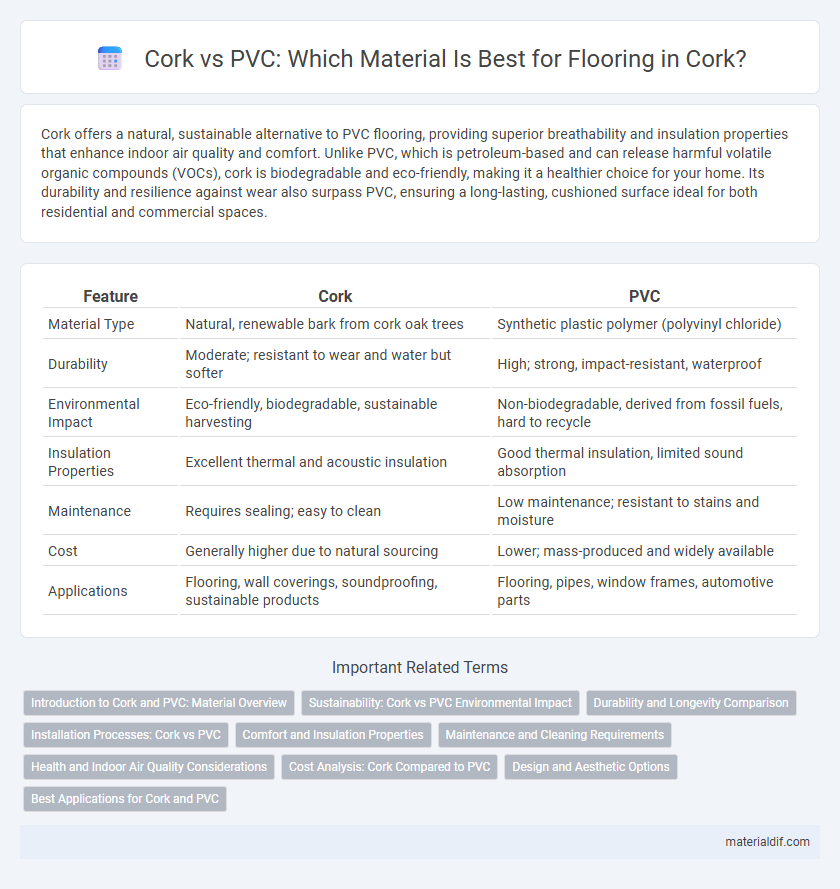Cork offers a natural, sustainable alternative to PVC flooring, providing superior breathability and insulation properties that enhance indoor air quality and comfort. Unlike PVC, which is petroleum-based and can release harmful volatile organic compounds (VOCs), cork is biodegradable and eco-friendly, making it a healthier choice for your home. Its durability and resilience against wear also surpass PVC, ensuring a long-lasting, cushioned surface ideal for both residential and commercial spaces.
Table of Comparison
| Feature | Cork | PVC |
|---|---|---|
| Material Type | Natural, renewable bark from cork oak trees | Synthetic plastic polymer (polyvinyl chloride) |
| Durability | Moderate; resistant to wear and water but softer | High; strong, impact-resistant, waterproof |
| Environmental Impact | Eco-friendly, biodegradable, sustainable harvesting | Non-biodegradable, derived from fossil fuels, hard to recycle |
| Insulation Properties | Excellent thermal and acoustic insulation | Good thermal insulation, limited sound absorption |
| Maintenance | Requires sealing; easy to clean | Low maintenance; resistant to stains and moisture |
| Cost | Generally higher due to natural sourcing | Lower; mass-produced and widely available |
| Applications | Flooring, wall coverings, soundproofing, sustainable products | Flooring, pipes, window frames, automotive parts |
Introduction to Cork and PVC: Material Overview
Cork, a natural material harvested from the bark of cork oak trees, offers excellent insulation, durability, and eco-friendliness due to its renewable and biodegradable properties. PVC (polyvinyl chloride) is a synthetic plastic widely used for its water resistance, affordability, and ease of maintenance, but it lacks the sustainability benefits of cork. Cork's cellular structure provides cushioning and breathability, while PVC's dense composition makes it suitable for moisture-prone environments.
Sustainability: Cork vs PVC Environmental Impact
Cork is a renewable, biodegradable material harvested from the bark of cork oak trees without harming the tree, making it an eco-friendly option with a low carbon footprint. PVC (polyvinyl chloride), a synthetic plastic derived from fossil fuels, poses significant environmental challenges due to its production process, non-biodegradability, and release of toxic chemicals during manufacturing and disposal. Cork's sustainable harvesting and natural biodegradability significantly reduce environmental impact compared to the chemical-intensive lifecycle and pollution associated with PVC.
Durability and Longevity Comparison
Cork flooring offers natural resilience with an average lifespan of 20-30 years, providing excellent resistance to wear and tear due to its cellular structure that absorbs impact. PVC flooring typically lasts 10-20 years, valued for its water resistance and ease of maintenance but prone to scratches and fading over time. Cork's ability to compress and return to its original shape enhances durability, especially in moderate-traffic areas, while PVC excels in high-moisture environments despite shorter longevity.
Installation Processes: Cork vs PVC
Cork flooring installation involves laying natural cork planks or tiles either as a floating floor over an underlayment or by glue-down methods, requiring precision to align the material and accommodate expansion. PVC flooring installation typically utilizes a click-lock system or adhesive application, allowing faster and more straightforward placement with moisture-resistant backing suited for various subfloors. Both Cork and PVC demand clean, level surfaces, but PVC's flexibility and uniformity generally result in a quicker, less labor-intensive installation process compared to cork.
Comfort and Insulation Properties
Cork offers superior comfort due to its natural elasticity and ability to cushion impact, making it ideal for flooring and wall insulation. Its thermal and acoustic insulation properties surpass PVC, as cork effectively regulates temperature and reduces noise transmission. Cork's breathable structure prevents moisture buildup, enhancing indoor air quality and comfort compared to synthetic PVC materials.
Maintenance and Cleaning Requirements
Cork flooring requires minimal maintenance, needing only regular sweeping and occasional damp mopping with a mild detergent to prevent moisture damage and preserve its natural texture. PVC flooring is highly durable and waterproof, allowing for easy cleaning with common household cleaners and making it suitable for high-traffic or moisture-prone areas. Both materials resist stains effectively, but cork demands more careful upkeep to avoid scratches and water exposure compared to the low-maintenance nature of PVC.
Health and Indoor Air Quality Considerations
Cork naturally resists mold, mildew, and allergens, contributing to improved indoor air quality compared to PVC, which can off-gas volatile organic compounds (VOCs) that negatively impact health. Cork is a sustainable, non-toxic material that does not emit harmful chemicals, making it ideal for allergy sufferers and those with respiratory issues. In contrast, PVC contains phthalates and other additives linked to indoor air pollution, raising concerns about long-term exposure in enclosed environments.
Cost Analysis: Cork Compared to PVC
Cork flooring typically costs between $5 and $9 per square foot, while PVC flooring ranges from $2 to $7 per square foot, making PVC generally more affordable upfront. Cork offers benefits such as natural insulation and durability that can reduce long-term maintenance expenses, potentially offsetting its higher initial price. In contrast, PVC may require more frequent replacement due to wear and tear, impacting overall cost-effectiveness over time.
Design and Aesthetic Options
Cork and PVC offer distinct design and aesthetic options for flooring and wall applications. Cork provides a natural, warm, and textured appearance with a variety of earthy tones and patterns that enhance cozy, eco-friendly interiors. PVC delivers a sleek, uniform look available in numerous colors and styles, mimicking wood, stone, or tile, making it ideal for modern or highly customizable spaces.
Best Applications for Cork and PVC
Cork excels in applications requiring natural insulation, soundproofing, and sustainability, making it ideal for flooring, wall coverings, and bulletin boards. PVC offers superior water resistance and durability, suited for piping, window frames, and outdoor signage. Both materials serve distinct roles: cork thrives in eco-friendly, comfort-driven environments, while PVC dominates in construction and industrial uses demanding resilience and moisture resistance.
Cork vs PVC Infographic

 materialdif.com
materialdif.com